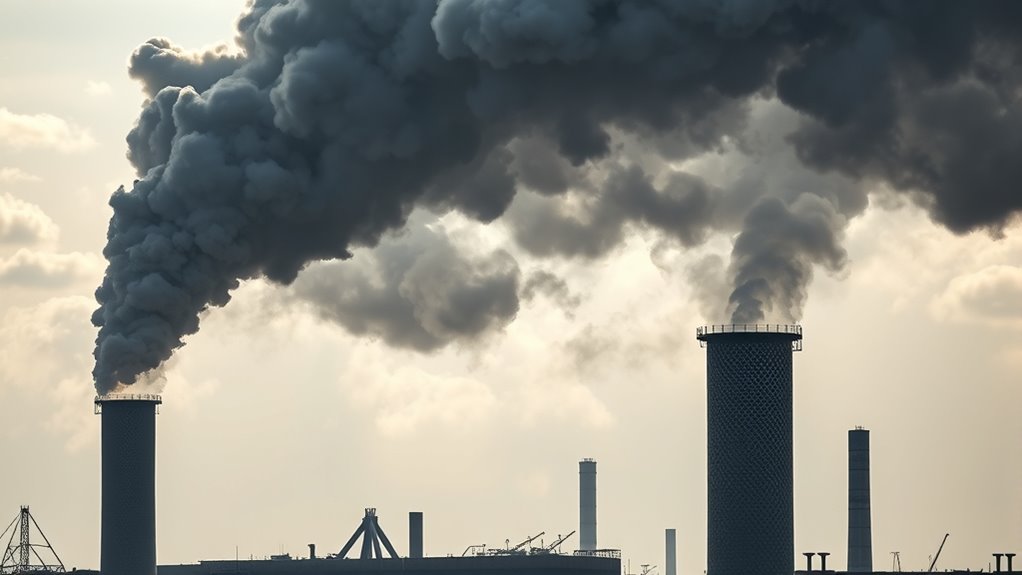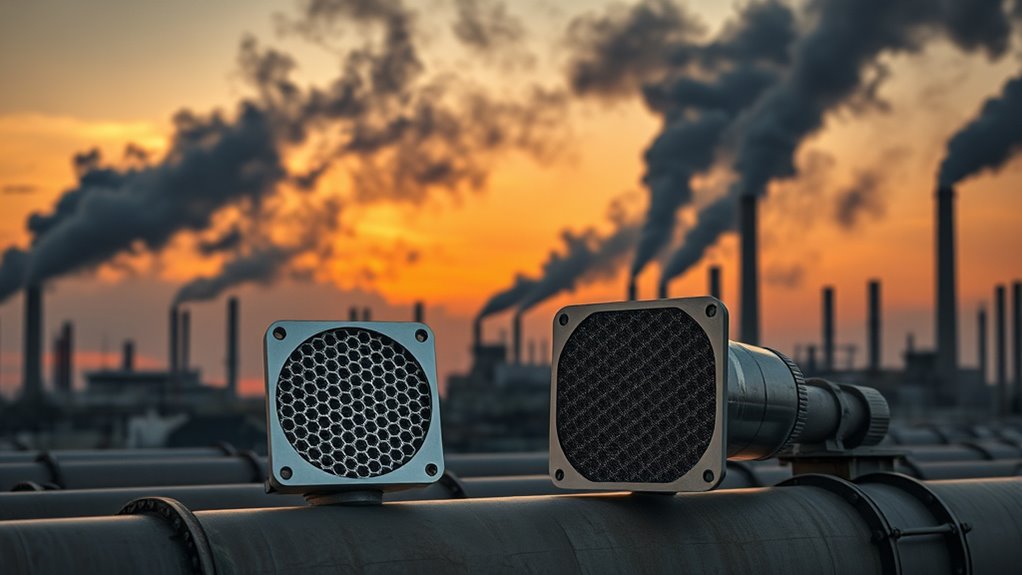Nano-filters using advanced nanomaterials are revolutionizing how industries control emissions by trapping tiny particles, volatile compounds, and toxic gases more effectively than traditional filters. These filters provide a larger surface area and capture pollutants at the nanometer scale, helping industries meet stricter standards and reduce environmental impact. They also enhance catalytic processes and lower maintenance costs. To discover how these innovative solutions are shaping cleaner industrial practices, keep exploring the key benefits and future possibilities.
Key Takeaways
- Nano materials in filters effectively trap microscopic pollutants, enhancing emission reduction in industrial processes.
- Nano-filters enable advanced catalytic processes to convert toxic gases into less harmful substances.
- Implementing nano-based filtration systems helps industries meet strict regulatory emission standards.
- Nano filters provide cost-effective, longer-lasting solutions that reduce maintenance and operational expenses.
- Adoption of nano-material filters supports environmentally responsible operations and minimizes industrial environmental footprints.

Industrial emissions are a major source of air pollution, releasing harmful particles and gases into the environment. These emissions often contain a complex mixture of pollutants, including particulate matter, volatile organic compounds, and toxic gases, which pose serious health risks to nearby communities and ecosystems. To combat this, industries are increasingly turning to innovative solutions like nano materials, which can dramatically improve filtration systems. Nano materials, with their extremely small particle sizes, offer a large surface area and unique properties that make them highly effective at capturing even the tiniest pollutants. When integrated into filters, these materials can trap particles at the nanometer scale, considerably reducing the amount of harmful emissions released into the air. Additionally, the high reactivity of nano materials allows for the development of advanced catalytic processes that further reduce emissions of toxic gases.
Nano materials enhance filtration by capturing microscopic pollutants, reducing harmful emissions and protecting public health and ecosystems.
However, the adoption of nano materials in industrial filtration isn’t just about technological feasibility; it’s also heavily influenced by emission regulations. Governments and environmental agencies have set strict standards to limit the amount of pollutants industries can release, pushing companies to adopt more advanced filtration methods. These regulations often specify maximum allowable concentrations of particulate matter and toxic gases, compelling industries to upgrade their systems to stay compliant. Nano filters, which leverage nano materials, can help companies meet or even exceed these standards because of their superior efficiency. They can be incorporated into existing emission control systems or used to develop new, more effective ones, ensuring industries stay within legal emission limits while maintaining production levels.
Implementing nano filters aligned with emission regulations also offers economic benefits. By reducing emissions more effectively, companies can avoid hefty fines and potential shutdowns. Additionally, advanced nano filtration systems often require less maintenance and have longer lifespans compared to traditional filters, lowering operational costs over time. The use of nano materials in filters not only helps industries meet regulatory demands but also enhances their reputation as environmentally responsible operators. Many firms see compliance as an opportunity to demonstrate their commitment to sustainability, which can positively influence their public image and customer trust.
In essence, the integration of nano materials into filtration systems is shaping the future of emission control. As regulations continue to tighten, industries will need to adopt innovative solutions like nano filters to stay compliant and reduce their environmental footprint. These materials enable more efficient capture of pollutants, making it easier for companies to meet regulatory standards while protecting public health and the environment. Embracing nano technology in emission control isn’t just a regulatory necessity; it’s a strategic move toward cleaner, safer industrial processes.
Frequently Asked Questions
How Cost-Effective Are Nano-Filters for Small Industries?
Nano-filters are quite cost-effective for small industries when you do a thorough cost analysis. They might have higher upfront costs but offer significant economic benefits over time by reducing energy consumption and maintenance needs. You’ll save money on waste management and comply with regulations more easily. Overall, investing in nano-filters can boost your industry’s efficiency and sustainability, making them a smart choice financially in the long run.
Are Nano-Filters Safe for Long-Term Environmental Use?
Nano-filters are generally safe for long-term environmental use if they have good durability, meaning they don’t easily break down or release harmful particles. You should consider their environmental impact, including how they are produced and disposed of, to guarantee minimal harm. When properly maintained and designed, nano-filters can effectively reduce pollutants without posing significant risks, making them a sustainable choice for long-term environmental protection.
Can Nano-Filters Remove All Types of Industrial Pollutants?
You see a shimmering nano-filter like a tiny fortress, but it can’t catch every pollutant. These filters excel at specific pollutants, thanks to their pollutant specificity, but struggle with others. Their filter scalability varies; larger filters handle more pollutants but may lose precision. So, while nano-filters are powerful tools, they can’t remove all types of industrial pollutants, requiring complementary methods for all-encompassing pollution control.
What Is the Lifespan of Nano-Filters in Industrial Settings?
Nano filters typically have an industrial lifespan of 6 to 12 months, depending on usage and pollutant levels. Their durability hinges on nano filter durability, which can be affected by contaminants and operational conditions. You should regularly monitor and replace them as needed to maintain efficiency. Proper maintenance guarantees you maximize their lifespan, keeping your industrial systems running smoothly and effectively filtering out pollutants over time.
How Do Nano-Filters Compare to Traditional Filtration Methods?
Nano-filters blow traditional methods out of the water with their incredible filtration efficiency and unmatched material durability. You’ll find them capturing even the tiniest particles that standard filters miss, making your air or liquids astonishingly cleaner. While traditional filters wear out quickly and struggle with tiny pollutants, nano-filters last longer, perform better, and are a game-changer in filtration technology. They’re the future you’ve been waiting for!
Conclusion
As you explore the potential of nano-filters, it’s almost surprising how these tiny innovations could reshape industrial emissions. Coincidentally, as industries seek cleaner solutions, nano-filters emerge as a promising answer—highlighting how innovation often arrives just when it’s most needed. Embracing these advanced filters might not only reduce pollution but also align technology with your commitment to sustainability, proving that sometimes, the smallest changes can lead to the biggest impacts.









